We all get the need for intensification in Ottawa. The news is full of stories about people who are having trouble finding affordable housing, whether they want to rent or buy. Naturally, it makes sense to locate new housing in reasonably central locations, near transit corridors and near the amenities people want to enjoy.
But intensification has to go hand in hand with preserving and improving our public green spaces, or it just results in urban decay.
For many decades, Ottawa was investing in the green spaces that make our city a great place to live. More recently, however, we’ve allowed property developers to build to maximise their own financial benefit, not the benefit of residents or the city as a whole.
Because the Ottawa City Council has been allowing this trend to continue, we are squandering our opportunities for long-term (and exponential) economic growth.
The lies that we’ve been sold are that green spaces are a financial black hole, and that we have to choose between intensification and green spaces. Believing these ideas has caused, and will continue to cause, Ottawa to miss out on opportunities to make incredible strides forward in how we live.

Pain vs Gain
When discussing new public spaces, the focus is always on the initial cost of construction. The proven long term financial benefit to residents and the city always seems to be left out, in spite of the fact that we have dozens of case studies that demonstrate the economic windfall dwarfs the initial expense by an astounding amount.
Typically, property developers and city councillors interpret the mandate for densification as a licence to fill in public green spaces, or to underinvest in them. The result is that the developers make excellent profits in the short term. But over time these neighbourhoods degrade and devalue because they don’t really attract long-term residents or businesses.
What the city and the developers are ignoring is the fact that well-designed green spaces naturally attract density along the perimeter, because that’s what the market does (more on that below).
It’s important to remember that it’s not just the wealthier people on the direct periphery of a park who benefit. People who live blocks away in more accessibly-priced housing will walk, bike, and even take transit to enjoy the space.
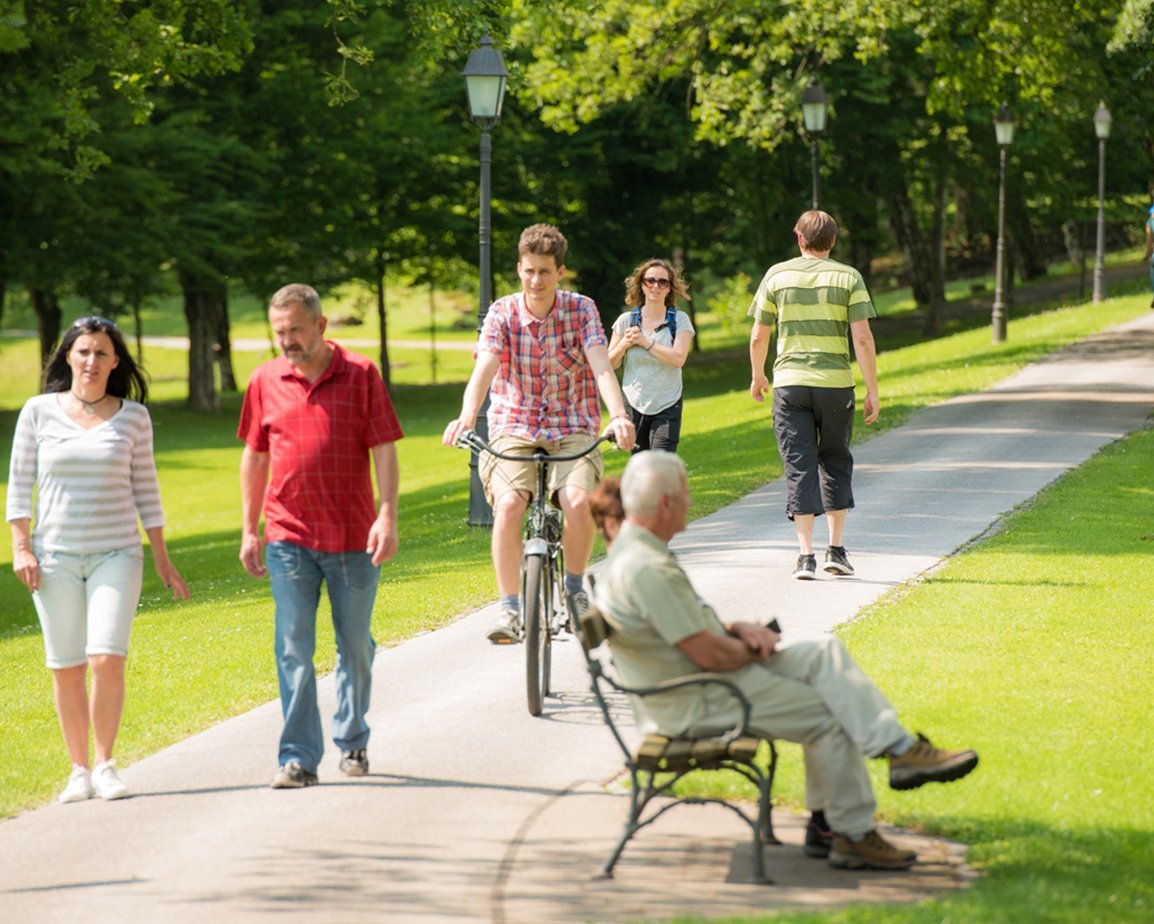
The Problems with Sprawl
For those who don’t know why Ottawa needs intensification, here’s a brief explanation.
After the Second World War, economic prosperity made cars more affordable. More prosperous second-generation immigrants, fearing newly arriving immigrants unlike themselves, sought the isolation of suburbs and fled the increasing plurality of cities. North Americans were willing to drive to the new suburbs where single-family homes were more cost-effective.
As people left the city centres for the new suburbs, the overall footprint of North American cities grew, and the abandoned residential areas of cities became derelict and prone to crime (a phenomenon known as “urban decay”).
As the flight to the suburbs continued over the decades, more expressways were needed, and existing expressways were enlarged. The resulting low-density growth in the footprint of a city was called “urban sprawl”.
Sprawl reduces quality of life by forcing people to spend more time in cars, which necessitates more land devoted to roadways, results in more pollution, and reduces the time people can spend on the activities that are meaningful to them. All told, the longer the commute, the greater the negative impact on physical and mental health. In major cities, it’s not unheard of for people to spend several hours a day commuting.
Sprawl also reduces the value of every infrastructure dollar spent. Larger cities require longer networks for water supply, sewer, electrical, gas, transit, roads and sidewalks. It means more money spent on construction and maintenance, especially in a climate like Ottawa’s where freeze-thaw cycles can be destructive to infrastructure and snow removal is a necessity. In short, the smaller the footprint of a city, the further tax dollars go.
Cost vs Value
Property developers typically aren’t interested in including viable green spaces in their projects because they make their money from saleable floor area. High-rise residential development in Ottawa is often an exercise in seeking short-term payback, with little investment made in good-quality materials that will look great in the future, let alone the long-term prosperity of the neighbourhood as a whole.

But when developers are allowed to build as cheaply as possible, buildings degrade faster. The resulting shabbiness creates an aura of malaise that drives out more prosperous residents who then take their spending power with them.
Building better neighbourhoods is more expensive in the short term, and property developers enjoy less of a profit margin.
The repayment, however, is manifold and extraordinary. Firstly, cities benefit from the increased tax revenue, part of which can pay for the creation and maintenance of local green spaces. The second benefit is to the local economy, when prosperous people flock to those areas to live. Businesses that want to serve these people follow suit, and business opportunities and economic growth follow.
With these ideas, are we leaving out economically disadvantaged people? Not if we make the effort to include more accessibly-priced housing along with the more expensive units. Everyone will have access to the same green spaces and other amenities.

How Public Green Spaces Enrich Local Economies
Green spaces go hand in hand with quality of life. This is just common sense: people want beautiful neighbourhoods with well-built and attractive buildings and places where they can enjoy spending time with friends and family, even if it’s just an evening walk with the kids and the dog.
They want their commutes to work to be more enjoyable, with the ideal being a half-hour walk. If you talk to any real estate agent they will tell you the same thing: people who can afford it will pay for walkable neighbourhoods close to amenities.

It’s a simple enough chain of events to understand:
- People want to live near green spaces because they make everyday living better.
- This demand increases the value of properties immediately bordering and close to green spaces.
- Wealthier people are drawn to these neighbourhoods.
- Wealthier people attract businesses who want to sell goods and services to them.
- These businesses create jobs, drive prosperity, and add to the list of amenities that continue to attract more people.
- Higher property values means higher property taxes, and more revenue for the city to cover the costs and care of green amenities.
This connection has been proven time and time again. From the creation of New York City’s Central Park in the 1880s to Boston’s Big Dig completed in 2007, and countless other successful redevelopments besides. We’ve seen it ourselves in Ottawa — we’ll talk more about these examples below.
Characteristics of Effective Public Green Spaces
We all know that plants need light and water, but judging from the plantings outside of some buildings, many developers have clearly forgotten their grade school science. A small hole in the pavement won’t provide trees with enough water when they’re grown, and certainly they won’t get enough light from living in the shadows of tall buildings all day, every day.
To allow street trees to live to maturity, green spaces depend on setbacks and limiting nearby building height.
The difference between a nine-storey building and a highrise can make the difference between an enjoyable walk and the dreaded concrete canyon, where buildings immediately contact sidewalks and sidewalks go right up to the road.
Small differences to how we build can make a big impact to quality of life and long-term value. On the left: setbacks and limited building heights can make room for mature trees and wider sidewalks. Contrast that with the image below.
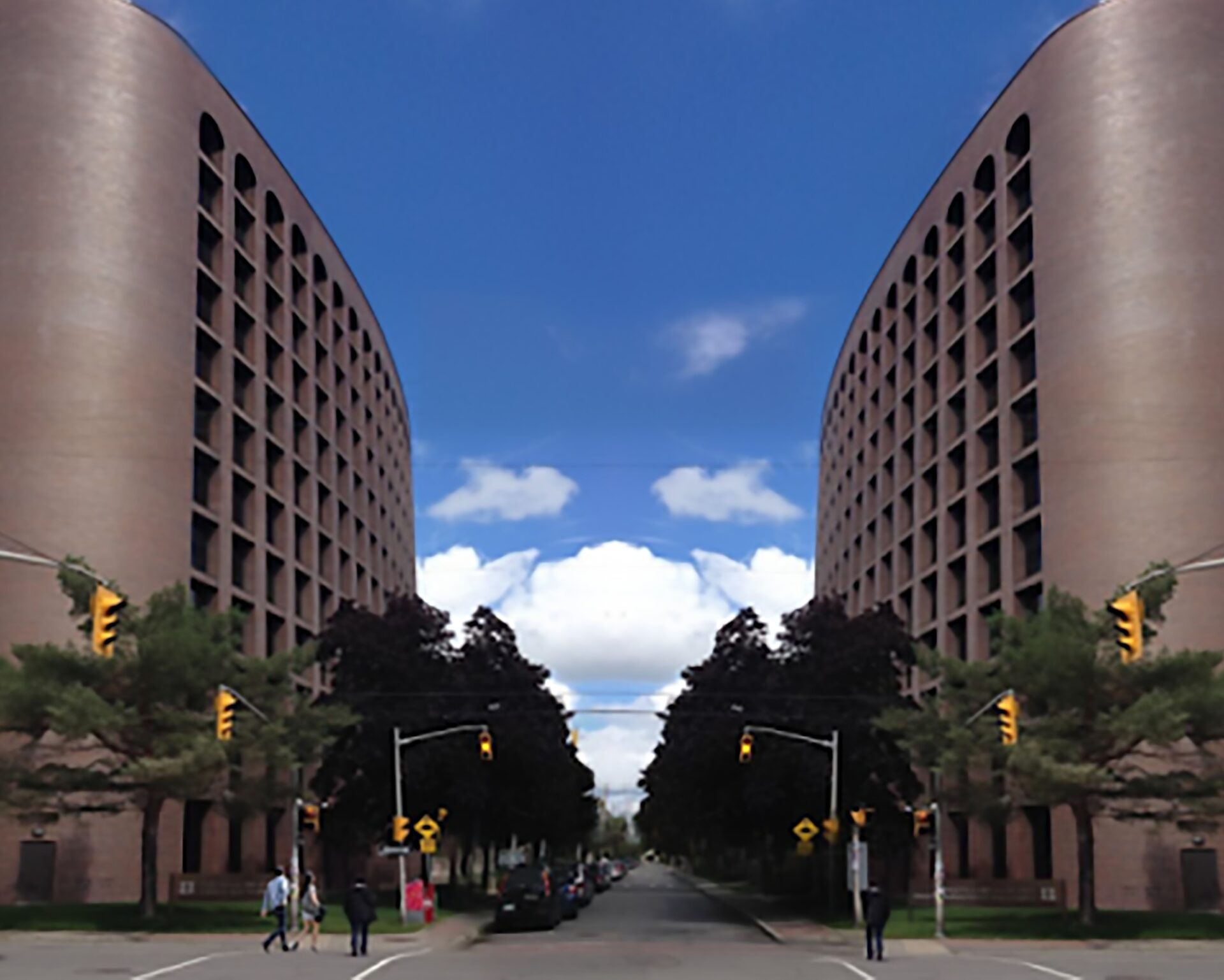
On the right: taller buildings and the “concrete canyon” effect. Where would you rather live?
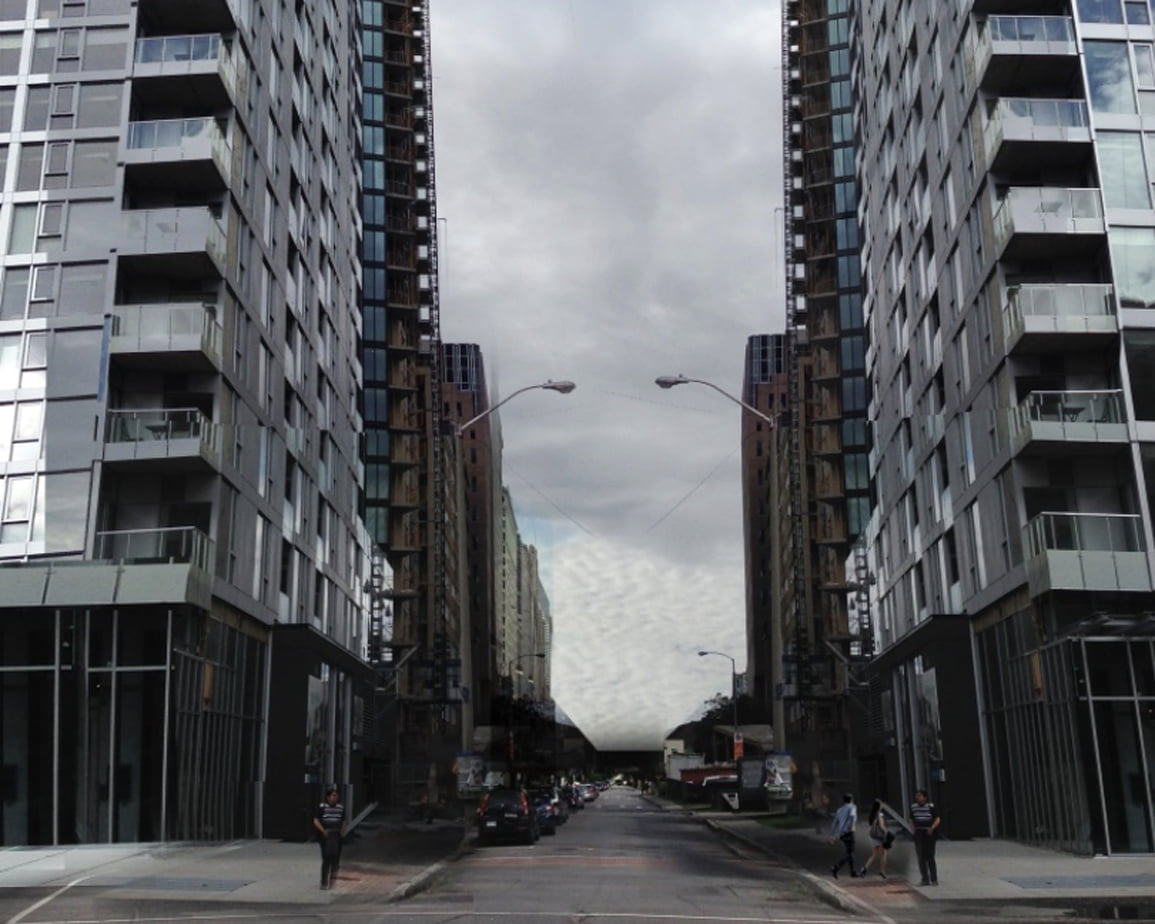
But even these more pleasant transitional zones don’t fully meet the needs for a public green space. These areas need to work for all ages and for multiple activities. They should encourage people not to just pass through, but to linger.
Well-designed green spaces need:
- To accommodate the aged, physically impaired, and families with small children — not just the physically fit.
- Wide sidewalks that allow families to walk side by side – in summer and also in winter when snow mounds will reduce dimensions.
- Public washrooms and, ideally, water fountains.
- Places to get food and beverages.
- Places where you can stop and rest and enjoy the space (even if you’re not patronising a restaurant or food stand).
- Visual, auditory, and physical protection from heavy traffic.
- Places to dispose of recyclables and trash.
- Regular maintenance (there will always be a few litterbugs).
Left: industrial transit beside the Canal as it existed until the middle of the 20th century.
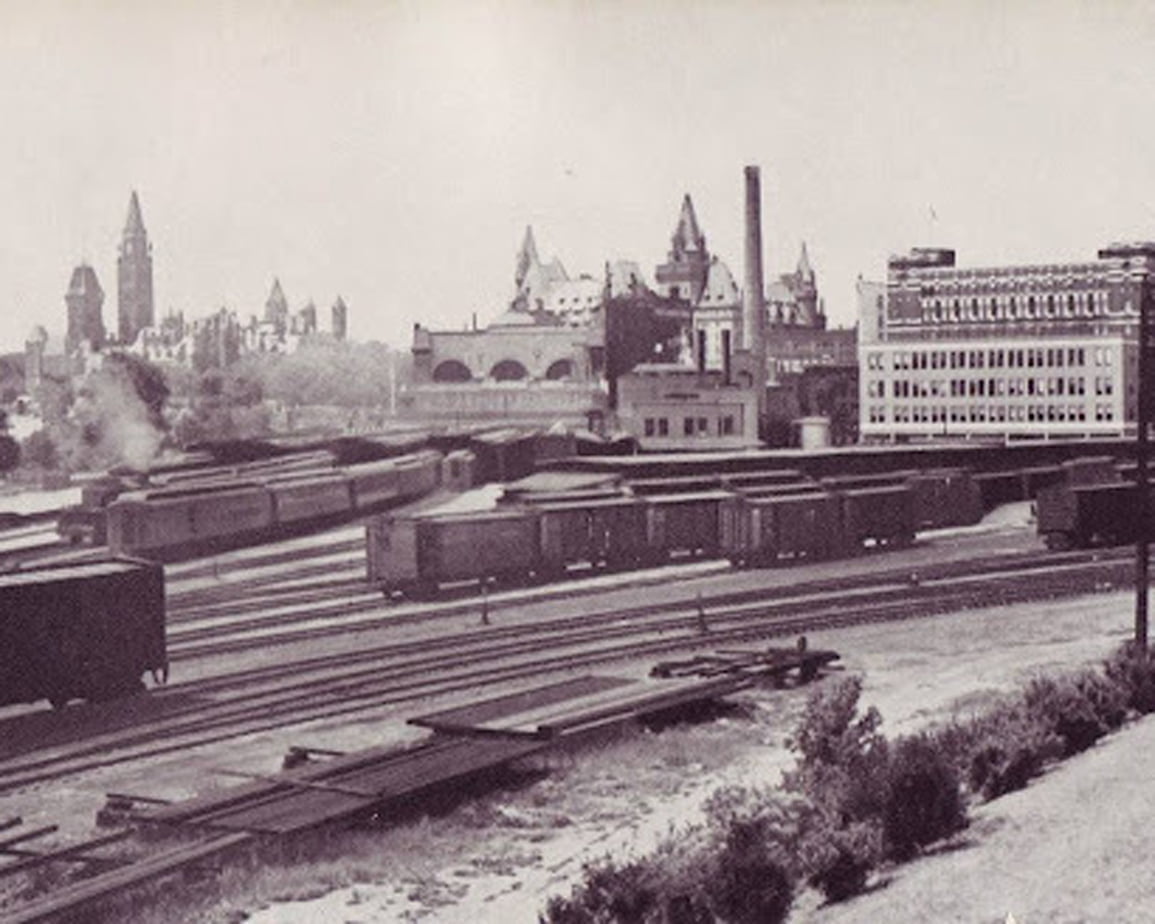
Right: the Canal today, with the railway replaced by lawns, trees, small gardens, and multi-use pathways.

Think about the Rideau Canal where it passes through downtown Ottawa. As a green space that was improved in the 20th century, it was certainly an aesthetic success. In the summer, however, it’s used almost exclusively by middle-aged, physically fit people who pass through on their commute or to exercise. While the canal certainly is a success for some people and even beautiful in spots, it’s not a truly democratic space.
In winter, however, things change when everyone goes there to skate. Public restroom facilities are brought in, as are all kinds of kiosks where people can get food and drinks, rent skates, and enjoy related activities. People have a great time, local businesses flourish, and in February when Winterlude activities are on, tourist revenue flows.
On the other hand, green spaces don’t necessarily have to be “functional”, contrary to what Barry Padolsky says in this article about the redevelopment of the Parliamentary precinct. If a green space has most of the basics listed above, people will find their own reasons to visit; every peaceful green area in a city is functional.
As any tired parent of small children will tell you, sometimes even a small space with a play structure and benches to sit on can make life so much easier. Parents can rest, socialise with neighbours, and provide supervision while their kids burn off some energy. People who aren’t parents can bring a book and read, meet a friend for conversation, or play with their dogs.
Reversing the Family Flow Problem
A key element in smart intensification will be how we make central neighbourhoods desirable for families.
Currently in Ottawa, as in other large North American cities, young people typically flock to the urban core after graduation to work and to enjoy the nightlife. Ten to fifteen years later when they pair up and want to start families, they often look to the suburbs for larger, more affordable homes with room for their kids to run around.

A liveable city is one where we can reduce the exodus of families from the core. But the scores of high-rise condos we have clearly aren’t the solution, because not only are they far away from suitable green spaces, they’re often so small that they’re not family-friendly. Really, these buildings are more like dormitories.
Smart intensification includes ways to entice families to remain in central areas, rather than fleeing to the single-family homes of the suburbs and contributing to sprawl.
How Intensification Can Be Wonderfully Liveable
Paris is often held up as one of the best European cities to both live in and visit despite the fact that the overwhelming residential architecture along every central street is mediocre. What makes Paris so liveable and walkable is its green spaces, and what makes strolling in Paris so magical is its wide and tree-lined sidewalks.
Closer to home, we can see the same principle at work with Island Park Drive, which is arguably one of Ottawa’s most desirable neighbourhoods. Its central location is certainly one advantage, but that is balanced by the fact that the street is clogged with heavy interprovincial traffic twice a day, even on weekends.
What makes that area so desirable isn’t the houses themselves; while most are larger heritage buildings, they’re not necessarily beautiful buildings from an architectural perspective. What really makes that area is that the buildings are set back from the road, and there’s a 20-ft strip of heavily-treed green space between the road and the lots. Access to multiple nearby parks, some quite large, adds to the appeal.
As mentioned above, adding greenery has to be done thoughtfully. As a counter example, consider Merivale Road, that hellish zone of congestion and big box stores. No one goes there for leisure or pleasure – one goes there when they have few or no other choice, and it’s extremely rare to see pedestrians on the sidewalks.
While there’s been an attempt to put some greenery on either side of the road, the unfortunate saplings are too closely surrounded by asphalt, and can’t get access to enough water, and then of course there’s the salt assault of winter. We’ve never seen these trees mature because they either can’t grow very much in a given year or die and get replaced.
The lesson here is that there is a minimum size for viable green spaces, below which they can’t survive.
Central Park and the Rise of Manhattan
In the 1840s, landscape architect Frederick Law Olmstead convinced Manhattan’s city planners to purchase 500 acres in the middle of the island — the site of the future Central Park. (The city later purchased an additional 340 acres.)
The purchase of the land prompted fierce real estate speculation as people rushed to buy plots close to the park. Almost overnight, land values around the park went up fivefold (and haven’t stopped increasing since). Within ten years the entire perimeter of the park had been developed.
Ever since then, the tax dollars of the residents closest to the park have more than paid for the creation and maintenance of the park. Not only do city residents use it, but people who visit from all over the world make a point of spending time there; it’s the city’s primary tourist destination along with being the front lawn of city residents.
You don’t need to start with unused farmland to experience this type of success. Almost any type of land, if it’s in the right location, can see this kind of reinvigoration. NYC has proved it multiple times with the redevelopment of the City Piers and the High Line. The City Piers and High-Line projects turned a former Meat Packing district from a squalid industrial zone to some of the most desirable real estate on the planet.
The High Line turned a disused elevated railway into a park that has become so popular that new hotels have sprung up, including one boutique hotel that straddles the High Line on stilts. (The right to build that hotel came tethered with the requirement that revenues from its well-heeled clients will pay for the High Line’s future maintenance.)
Right: a view of the High Line today and one of its water features.
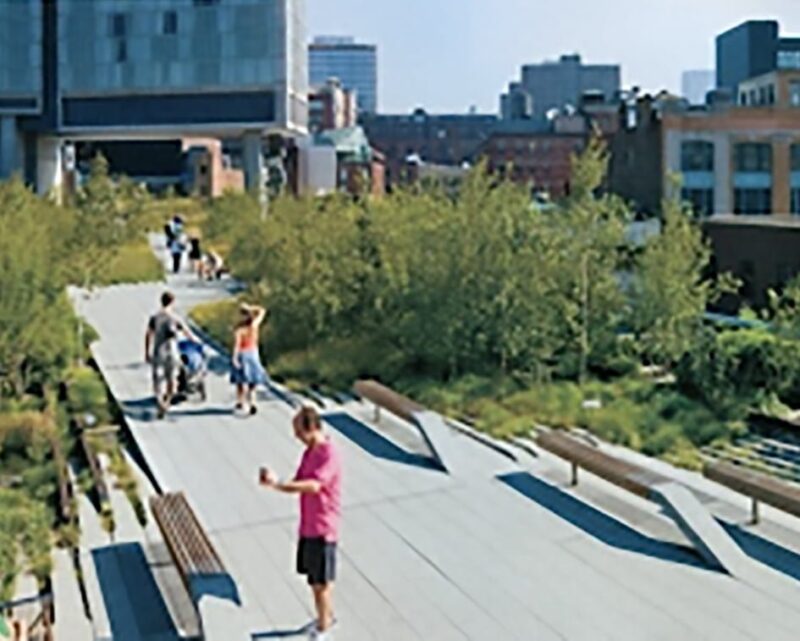
Left: the Standard, High Line Hotel astride the High Line.
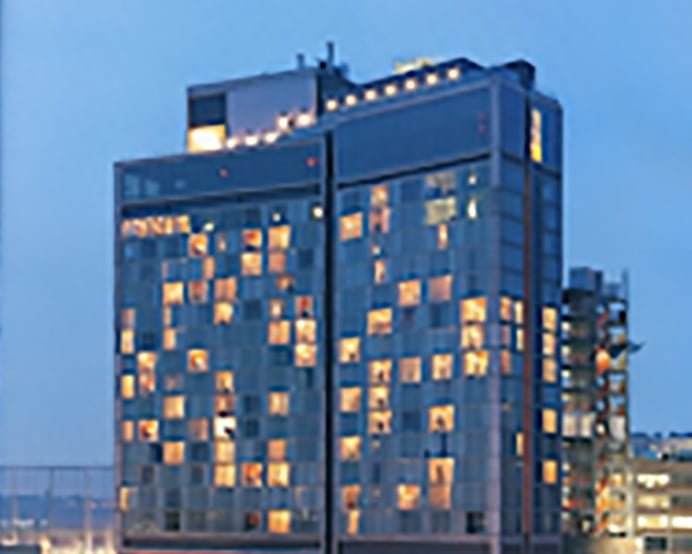
These projects worked not because New York City is magical, but because city planners are shrewd and have continuously reinvested in what works — investing in public green spaces and the arts — and have learned the lessons from what has not. (New York City had a huge urban decay problem in some boroughs in the 1970s and 1980s until it began a number of revitalization projects that encouraged families to return).
Boston’s “Big Dig” moved expressways underground, reduced commutes to the centre of the city from 20 minutes to 3 minutes, and created green space that — you guessed it — resulted in a massive increase in nearby land values relative to the rest of Boston.
Boston’s Big Dig before (on the right) and after completion (on the left).
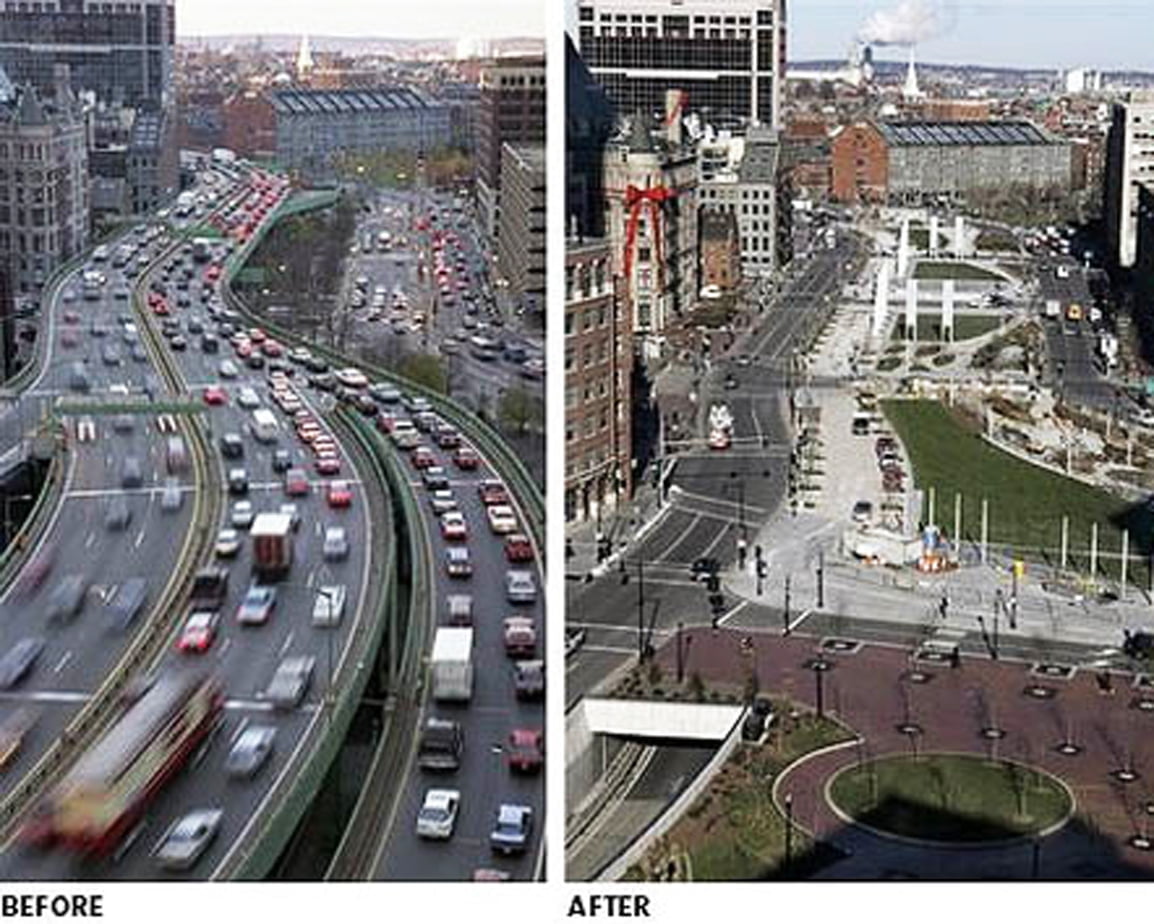
Ottawa Must Learn the Lessons of Smart Intensification
The city of Ottawa is at a pivotal moment in its history. The competing pressures of the need to intensify vs the need to improve livability are being played out like a car crash in slow motion.
On the left: the boulevard Maisonneuve redevelopment in Gatineau before work began.
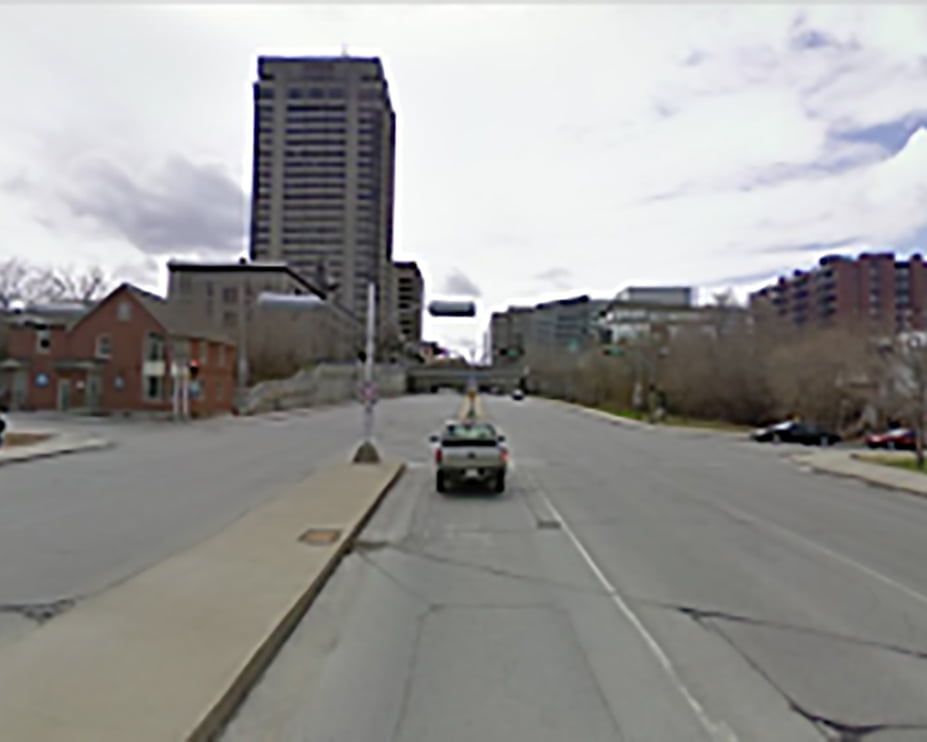
As we’re seeing with the development of Lebreton Flats and as we’ve seen with the redevelopment of Lansdowne Park, if you turn prime real estate over to property developers, they will skew towards creating very ho-hum housing and shopping. There will be little to no room for truly liveable spaces and the kinds of amenities that will draw other Ottawa residents and tourists.
On the right: The boulevard Maisonneuve redevelopment in Gatineau and the approved plan, showing more green space, including on medians.
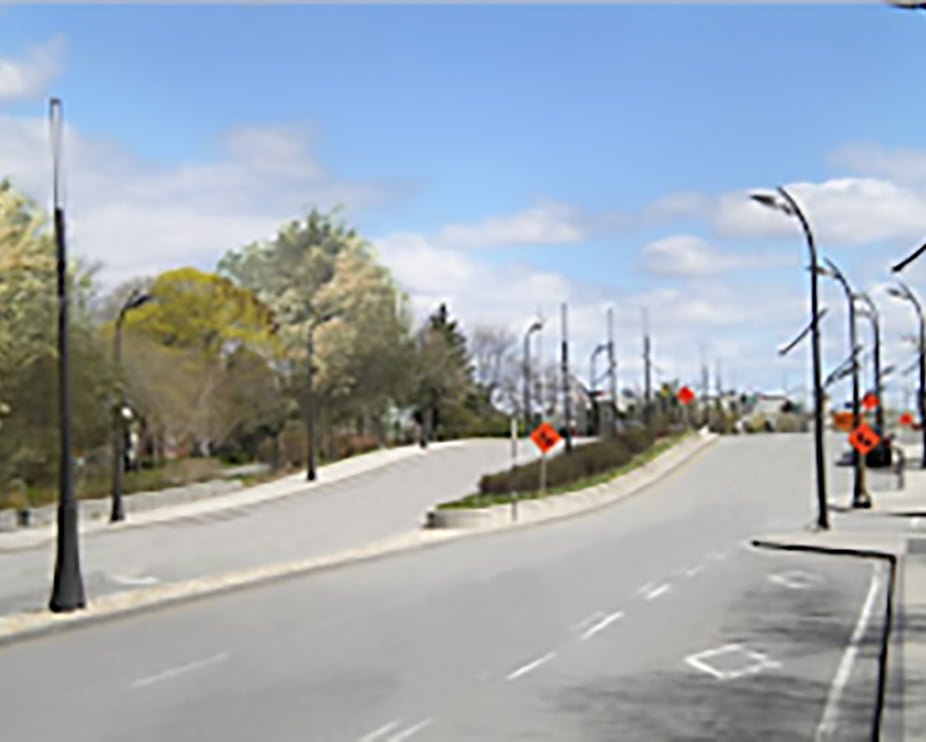
We can no longer keep using upfront costs as an excuse. The City of Gatineau, which brings in fewer tax dollars than Ottawa by a long shot, was able to redevelop Maisonneuve to a very walkable space.
If we can’t learn how to do the same, Ottawa will no longer be an attractive city in which to live and work. Downtown Ottawa will of course not die given the strong presence of the government; but, it will increasingly be a place where people remain largely, or even solely due to the constraints of their work despite the downtown core further losing vitality and beauty.

